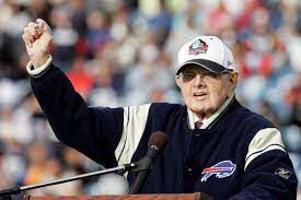
Back in the early 1970s, before coaching in the National Football League became a year-round proposition, the draft was held in late January.
Shortly after the ’74 lottery – this was well before minicamps and Organized Team Activities (OTAs) – then-Bills coach Lou Saban talked about “taking some vacation.”
But he pointed out, “I don’t want to go to different places and do all sorts of things … my idea of relaxation is to sit on a beach and read a book.”
At times, I’ve followed that posture … including this summer.
The suggestion came courtesy of Tyler Dunne, the former Times Herald intern who has covered the Packers for the Milwaukee Journal, the Bills for the Buffalo News and the NFL for Bleacher Report.
And when the latter opted for streaming at the expense of its print product, he started his own business, a website called Go Long with Tyler Dunne, dedicated to feature-length NFL stories along with a weekly Happy Hour podcast.
Counting down to Go Long’s first anniversary, several times Dunne touted one of his all-time favorite books, America’s Game, subtitled The Epic Story of How Pro Football Captured a Nation. It was written by Michael MacCambridge and published in 2004 with an updated “afterward” a year later.
THE BOOK isn’t short – 463 pages, including the epilogue and afterward – and, admittedly, its biggest appeal is to NFL fans age 50-or-older who have lived through the merger with the American Football League, or longer.
But for that audience it’s an enlightening insight into the factors that played into pro football’s growth in popularity.
There’s the embarrassing racism that went from an all-white game in the late 1940s to the current version which is 70 percent minorities, the impact of television, acrimony between owners and players, challenges from upstart leagues, the controversy of franchises moving and, of course, the landmark merger between the NFL and AFL in 1966.
THEN, TOO, the book somewhat details the Bills’ part in pro football history.
— Start with the fact that when the AFL was forming, Ralph Wilson, a minority owner of the Detroit Lions, was granted a franchise and had the option of putting it in either Miami or Buffalo.
His preference was South Florida, but stadium issues precluded that choice. Instead he opted for Buffalo, though the league’s other owners were concerned about the severe winters and the perception that the city was too small to support a team.
— In the AFL’s second year (1961), Wilson lent $400,000 to Wayne Valley, the Oakland Raiders’ original owner, a move that helped keep the league alive.
— The Bills were peripherally a part of an impactful 1962 draft. That year, the NFL’s Washington Redskins had the No. 1 overall pick and chose Ernie Davis, the All-American running back from Syracuse, whom Buffalo selected with the fourth pick in the AFL’s first round. He was a player coveted by Cleveland Browns owner Art Modell, so George Preston Marshall, who owned the Redskins, an all-white team, and feared he’d lose the Heisman Trophy winner to the Bills, offered a deal. Washington would send the rights for Davis to the Browns for running back/wide receiver Bobby Mitchell and Cleveland’s ’62 first-round pick, halfback Leroy Jackson.
During a routine rookie physical, Davis was diagnosed with leukemia and 10 months later he was dead at age 23, never playing a down for the Browns. Meanwhile, Mitchell became Washington’s first-ever Black player.
— Buffalo was also, unwittingly and unhappily, part of an incident that nearly foiled the eventual merger. The Bills had picked placekicker Pete Gogolak in the 12th round of the 1964 AFL draft – no NFL team chose him. Born in Hungary, he was anecdotally the initial soccer-style kicker at a U.S. high school and, for sure, was the first in college (Cornell) and pro football.
Gogolak was second in AFL scoring his first two seasons, hitting a pro-record 28 field goals (over 14 games) in 1965. But after that season, the NFL’s New York Giants, who had converted only four of 26 field goal attempts that season, violated an unwritten rule and signed a player from the rival league. They gave Gogolak a three-year $96,000 contract, the most ever paid to a kicker.
— But while most AFL owners were furious about the signing, Al Davis, who owned the Oakland Raiders and was league commissioner, concluded, “We just got our merger … if we go out and sign their players, we’ll destroy them and they’ll come to the table.”
MacCambridge called the hijacking of Gogolak, “arguably the single most proactive act of the decade (1960s) in the war between the leagues.”
— Equally interesting were the merger talks. Lamar Hunt, founder of the AFL and owner of the Dallas Texans, who eventually became the Kansas City Chiefs, wanted the two leagues to merge, but his own commissioner, Davis, wanted to fight the NFL.
Thus, Hunt, when meeting with the established league, brought only Wilson and the Boston Patriots’ Billy Sullivan and never told Davis. The NFL countered with Tex Schramm (Dallas Cowboys), Carroll Rosenbloom (Baltimore Colts) and Dan Reeves (L.A. Rams) and those half-dozen owners hammered out a merger deal, though it took months.
— Finally, even after the merger, owners couldn’t agree on how the divisions should be aligned, especially the AFC East. Finally, NFL commissioner Pete Rozelle put the five most popular alignments in a vase and his secretary pulled out the slip that listed this division: Baltimore, Boston, Buffalo, Miami (Dolphins) and the New York Jets.
Eventually, the Patriots dumped the name Boston for New England and the Colts moved from Baltimore to Indianapolis, but those five teams comprised the AFC East for 31 years.
